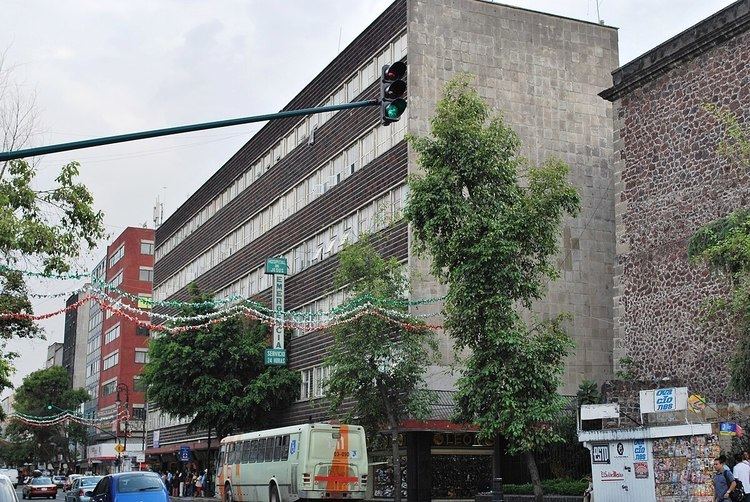Affiliated university Independent Founded 1524 | Phone +52 55 5542 6501 | |
 | ||
Other links Media related to Hospital de Jesús Nazareno at Wikimedia Commons Address 20 de Noviembre 82, Cuauhtemoc, Centro, 06090 Ciudad de México, CDMX, Mexico Hours Closed now Tuesday9AM–8PMWednesday9AM–8PMThursday9AM–8PMFriday9AM–8PMSaturday9AM–8PMSunday9AM–8PMMonday(Benito Juárez's birth)9AM–8PMHours might differ Similar Historic center of Mexico City, Church of San Bernardo, Palace of the Marqués, Nuestra Señora de Loreto Ch, Old Portal de Mercaderes | ||
Hospital de jes s nazareno fundado por hern n cort s
The Church and Hospital of Jesús Nazareno buildings are located in the Historic center of Mexico City, in México, D. F., Mexico. The hospital is still in operation, housed in a Modernist building, located in front of the original one, and beside the former church. Both historic buildings and their courtyards are 17th century Spanish colonial era architecture.
Contents
- Hospital de jes s nazareno fundado por hern n cort s
- 40a hospital de jes s nazareno c rdoba
- History
- Buildings
- Hospital
- Murals
- Corts tomb
- References
40a hospital de jes s nazareno c rdoba
History
The Church and Hospital are supposedly located at the spot where Hernán Cortés and Moctezuma II met for the first time in 1519, which was then the beginning of the causeway leading to Iztapalapa. Cortés ordered the hospital built to tend to Aztec soldiers wounded fighting with the Spanish.
In his last will, Cortés clearly states that he wanted the hospital to be built for the sons of the Aztec warriors who had perished in battle during the Conquest of Tenochtitlan. This was not an institution for wounded Spanish soldiers. It was built many years after the Spanish conquest of the Aztec empire.
In 1646, the hospital was the site of the first autopsies performed on the American continent, performed to teach anatomy to medical students of the Royal and Pontifical University of Mexico. In 1715, the hospital published the Regia Academia Mariana Practica Medica to promote more professional practices in the field of medicine in New Spain. The building today continues to function as a hospital.
Buildings
The complex consists of a church and the hospital divided into four sections. The original hospital building is hidden by a Modernist façade, but the façade of the adjacent church is original. After passing the main entrance, one comes to a two-story colonial courtyard filled with plants and a fountain in the center. The hospital courtyard was originally decorated with Tuscan columns, but have since been replaced by equally austere ones. The original staircase remains, which contains a bust of Cortés and past this staircase is a second courtyard. One courtyard was for men and the other for women. The best-known portrait of Cortés can still be seen here. On the frieze of the upper corridors of the south side have a series of small and grotesque faces, which are popularly and mistakenly considered to be those of Cortés’ relatives.
Hospital
The Jesús Hospital is one of the oldest buildings in Mexico City. It was most likely operating by 1524, although this is disputed, since it was one of three hospitals started around the same time, and various records have different dates for the first opening. The hospital with its church was originally called Purísima Concepción. At the beginning of the colonial period, it was popularly known as the Hospital del Marqués.
The hospital was originally designed by Pedro Vázques, and Cortés left a number of farmlands in his will for the benefit of the institution. Cortés died before the hospital building was finished, and the colonial government of New Spain hired Alonso Pérez de Castañeda to replace Vázques. Six years and 43,000 pesos later, it was still not finished.
130 years later Antonio de Calderón Benavides was named head of the institution and worked to finish it. At this time the hospital received an image of Jesus of Nazarene, and the hospital was renamed after the image when it was finally dedicated in 1665.
To one extent or another, just about all of major architects in the Viceroyalty of New Spain were involved with the buildings, from construction to repair work. Some of those include: Claudio de Arciniega, Diego de Aguilera, Sebastian Zamorano, Pedro de Arrieta, and Francisco Antonio Guerrero y Torres.
Murals
The Church of Jesus Nazareno was stripped bare. However, the choir and part of the nave conserve a long mural painted by José Clemente Orozco. The work was inspired both by the Apocalypse and the horrors of the Second World War. Orozco worked on this from 1942 to 1944, but left it uncompleted.
The small dome resting on the church tower has an image of the Archangel Michael that is often mistaken as a portrait of Cortés. The coffered ceilings with golden flowers on a blue background on the sacristy are the work of Nicólas de Ylleascas.
Cortés tomb
The remains of Cortés were placed in the church portion by Viceroy Revillagigedo in 1774. At the same time Manuel Tolsá created a bust of the conquistador as well as his coat of arms done in bronze. Today, there is still a small plaque at the front of the church, to the left of the main altar to indicate the tomb. However, in August 1882, there was a proposal to move the remains and place them next to those of some of the heroes of Mexican War of Independence, but this caused an uproar with some trying to desecrate the tomb in the church. The remains were removed to a secret secure site.
